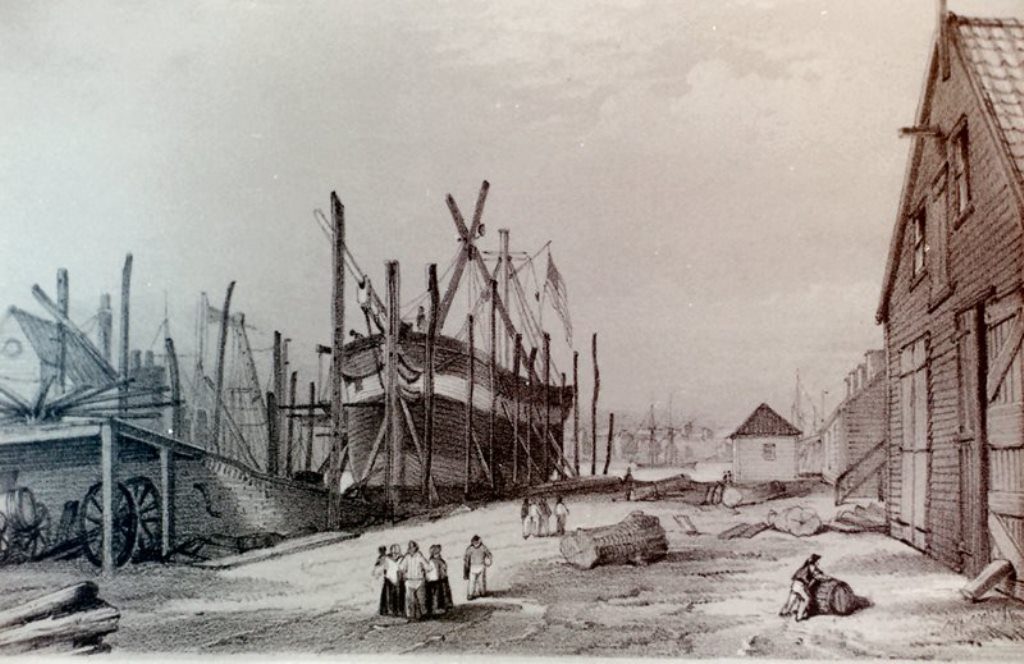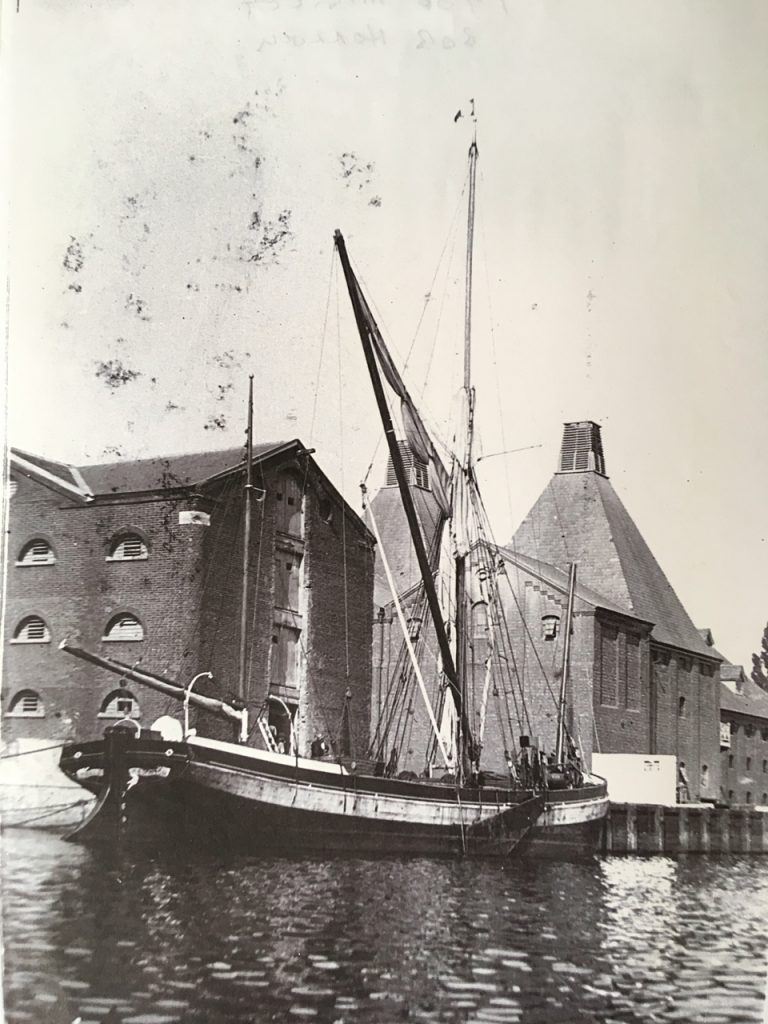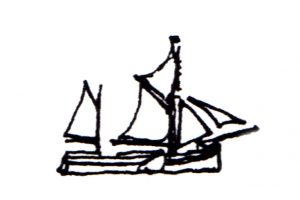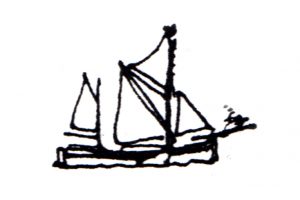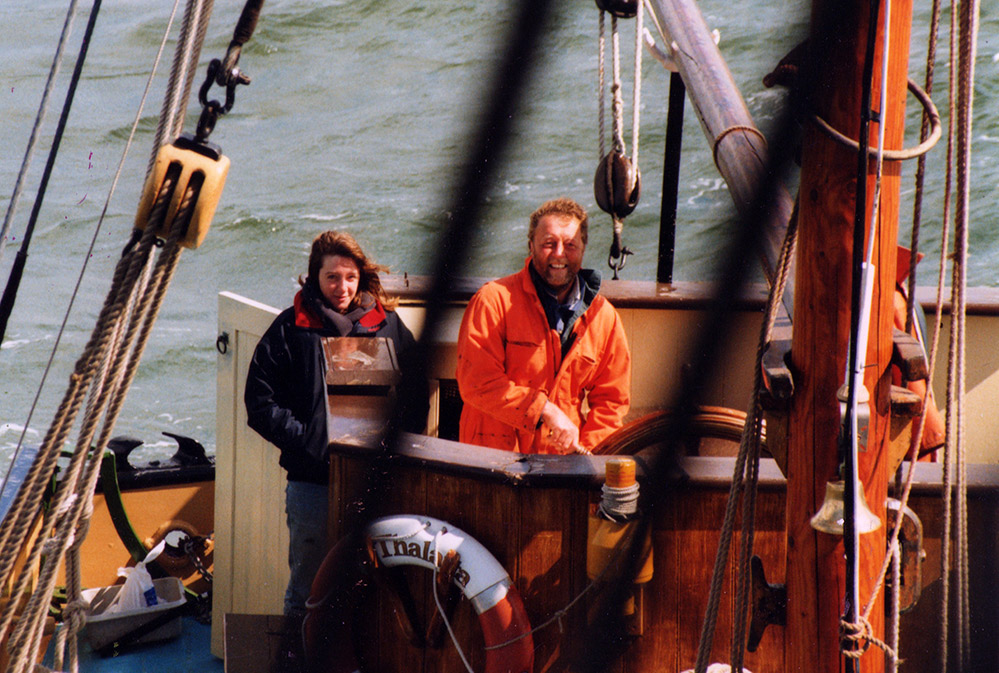Anything to add?
Thalatta was built at the naval yard in Harwich by W. B. McLearon, who from 1905-1906 was Mayor of Harwich. The sailing barges that came from McLearon's yard were considered to be the finest that could be found anywhere on the coast, as collectively they survived in better condition than those from any of the other builders of the time. Mclearon was also a builder of wooden lightships for Trinity House, and this is further proof of the exceptionally high quality of his work and materials. Thalatta was built as a speculation along with her sister barge Ena. As Thalatta…
Read More
Barge Launched at Harwich An interesting ceremony was witnessed in the shipbuilding yard of Mr W McLearon, at Harwich today (Tuesday 6 February 1906) when a new barge, which has been built in the yard, was launched in the presence of a large number of people. The barge, which was christened the Thalatta is owned by Mr Frederick William Horlock, the well known boat owner of Mistley. She is a fine business like looking craft, being 89 feet long, beam 20ft 6 inches, depth 7 feet 6 inches, and her tonnage is 150. She will be used for the coasting…
Read More
Thalatta left Harwich for Mistley to load her first cargo, wheat for London. In 1906, as well as the east coast ports of Lowestoft, Harwich, Mistley, Hull and London, her passages took her to the near continent including Antwerp, Dunkirk, Nieuwpoort and Rotterdam. She also carried malt to Ireland. These destinations clearly indicated that she was considered to be a good sea-going vessel – a quality which not all of her kind could claim. Her first skipper was Jim Alliston, of Mistley.
Thalatta in 1906, Butterman's Bay, on the Orwell, not far below the Butt and Oyster. Thalatta is the outer barge of the two double moored at the stern of the steamship. Butterman’s Bay was an anchorage used by ships too big to get up to Ipswich. Here they would off-load their cargo into sailing barges take up the Ipswich docks. The picture possibly shows grain being loaded by a shoot onto the barge in front of Thalatta, which would be quite likely as there were two millers in Ipswich docks at that time.
When Fred Horlock had made up his mind to buy Thalatta he insisted she be rigged as a 'spritty' (spritsail) and not as a 'boomie' (a boom and gaff mainsail), as she had originally been intended. It was a decision he apparently later regretted, and she was taken back to Harwich by her Skipper James Alliston to be re-rigged as a boomie at some early point. The spritsail rig was designed for the calmer waters of the River Thames and the estuary, and was not the ideal rig to have on a sea-going vessel.
In November 1908 she was caught in a heavy storm when on passage from Sunderland to the Thames, and was towed into Lowestoft with a broken main gaff and a torn sail; seven other barges were either lost or driven ashore in this storm.
In January 1909, when loaded with maize from the London Docks, she was in collision with the steamer Forth in Blackwall Reach, sustaining considerable damage to her starboard side, and had to be repaired by Shrubsall’s at Greenwich before continuing her voyage.
Thalatta carried some coal freights to the continent (and once returned home with a cargo of eau de Cologne!) before being taken over by the Royal Navy for use as a fleet supply vessel. The Navy gave her a small semi-diesel engine as an auxiliary, but according to all accounts this was never very much use to her, and it was removed a year or two after her return to civilian employment.
In 1916 Thalatta ran between Shoreham and Dieppe deep loaded with pig iron to feed the French war machine. Many barges were destroyed during wartime at sea but Thalatta avoided the mines and submarines.
On 25 May 1917 Thalatta was sold to Wynfield Shipping Co of Grimsby. A 70 hp two-cycle vertical oil engine was fitted in the former skipper’s cabin aft, built by Plenty & Sons of Newbury. She was used as a supply vessel to the Humber boom defences, with Percy Richmond as her skipper (who had previously been mate under James Alliston). Her fore-hold was converted to accommodate her crew which now included an engineer. Her rig was cut down and she worked from Grimsby as a motor barge – her original registration as a sailing vessel was cancelled.
At the end of the war Percy Richmond left Thalatta and one of the Wynnfield Company's wartime skippers, Herbert John Body, of Southend, took over as skipper. Thalatta was employed taking materials to the depths of war-torn Flanders for post-war rebuilding. Many years later, Thalatta was recalled by a Mr E. Taylor of Chatham, who was at that time a boy working in the barges, as working her way up the canal through the barren, empty, sorrowful fields of Ypres, so recently the scene of unimaginable horrors. Mr Taylor recalled the absolute quiet of that awful place – 'a quiet…
Read More
On 19 May 1923 Thalatta was sold to her skipper, Captain Herbert John Howlett Body, who removed the engine, and replaced her gaff rigged mainsail with a spritsail, but she retained her gaff mizzen – making her a mulie. This reduced the crew from the boomie’s four to two men and a boy. Body traded her to ports on the north-east for coal and the south coast with wheat, as well as the near continent.
In 1932 Thalatta is known to have delivered materials to Lewes in Sussex to build a new railway line.
On 5 August 1933 Thalatta was sold for £450 to R. & W. Pauls and was employed carrying imported grain from Royal Docks in London to Ipswich, returning with malt or flour. The malt was made from Suffolk barley and was taken to London to be made into beer. She also took animal feed to Colchester and Faversham. Generally Paul’s barges avoided rough trade such as carrying rubble from London after the war to build the air fields of East Anglia or ‘London mix’ – hay to London for the London cab’s and manure back east to the farms. Their main…
Read More
Thalatta narrowly missed being sent to Dunkirk in 1940. Sixteen Thames Barges were among the boats sent to help evacuate the hundreds of thousands of British soldiers trapped on the beach, and six of them were from R. & W. Paul. Why Thalatta was left behind nobody knows, but it is possibly due to not having an engine installed in her at that time. Nine of the sixteen barges sent over never returned. But of the ones who did, one of the most bizarre return journeys was made by Ena, the sister barge of Thalatta. Ena had been abandoned in…
Read More
In 1946 the Clacton lifeboat Edward Z Drezden assisted Thalatta into Brightlingsea after she had got into difficulties near the Gunfleet Sands.
In 1947, her new skipper, Joe Lucas, sailed her to Richards’ yard in Lowestoft where she was again fitted with the second auxiliary engine of her career – a 80 h.p. four-cylinder marine diesel by Ruston & Hornsby of Lincoln – one of many war surplus engines which had originally been ordered for minesweepers during WWII. Thalatta's owner, R & W Pauls, managed to get hold of half a dozen of them at a good price, for use as auxiliaries in their barges. At the same time she also had a complete refit and a wheelhouse was installed.
Thalatta's skipper from 1950 until 1956 was Charlie Webb (pictured here with Harold Smy in 1974). From 1956 to 1960, her skipper was Bob Wells, and then from 1961 (we believe) until 1965 she was skippered by Fred Roberts. Fred Roberts' last command was Thalatta, and he passed away in 1966. R. & W. Paul looked after the barge well with their own team of shipwrights and sailmakers. She was found to be unusually sound and well-preserved condition when her last Board of Trade loadline inspection was carried out in 1964.
Thalatta loaded with grain for Rochford. By the time this photo was taken in 1964, Thalatta had spent 30 years with R. & W. Pauls and had been treated very well, the work being fairly easy with mostly small cargoes of malt. Her mainmast and a foresail are all that remain from her sailing gear by this point.
Thalatta was sold to John Kemp for the sum of £1500 on January 30th, 1967. She was bought as a replacement to the Memory, who had completed two seasons as a schoolship with John Kemp as Skipper and Jane Benham as mate. By the end of 1966 it had become clear that the Memory was no longer in good enough condition to continue with this work. The gear from the Memory was transferred to Thalatta to re-rig her as a mulie (boom and gaff mizzen with spritsail main). She retained the quarterboards which raised the height of her rails aft. Her hold…
Read More
The pages from Thalatta's old cargo book show that her last full year of work for R. & W. Paul was in 1965. In January 1966 she carried malt from Ipswich to London and brought oil cake (a type of animal feed) back again, remaining unused for most of the year. Her two final trips under ownership of R. & W. Paul were in October 1966, the final one being a trip to Maldon for refitting. By 24th April 1967 she was ready for her first 5-day voyage with children from the London Borough of Redbridge.
Thalatta had a new suit of sails built for her in 1971 at the Ipswich sail lofts of J. O. Whitmore. They were made of Royal Navy flax canvas and roped with Italian hemp. The new sails would remain undressed initially, so that any adjustments could be made. Then they were protected from the weather with a special dressing made with codfish oil, red ochre and yellow ochre. The bolt-ropes were treated with stockholm tar.
A prospectus from 1972. From 1967 until 1976 Thalatta was jointly operated by the East Coast Sail Trust and the Education Department of the London Borough of Redbridge. During those years hundreds of school children from the east London borough spent a week on Thalatta, exploring the east coast that was virtually on their doorstep, but which seemed to many of them to be very much ‘another world’.
The old Ruston & Hornsby which had been installed in 1947 was replaced with a brand new Kelvin in 1973. The new Kelvin served well for nearly 30 years until Thalatta's Centenary Restoration project in 2006-12, when it was replaced.
In 1973 the East Coast Sail Trust bought and re-equipped the Lady Jean as a second Trust barge. On April 29th 1974 Lady Jean was renamed the Sir Alan Herbert by Lady Herbert at Tower Pier in London, in memory of her husband whose love of barges was well known. At that naming ceremony was Edward Heath, who had been Prime Minister until losing the General Election in February that year.
The Thalatta Coast Survey was described as an 'exploration of the English coast, undertaken by school pupils working from their own coast survey vessel Thalatta, to compile a lasting record of the area in the late 1970's. Aspects of the coast that were studied included History & Tradition, Man & Wildlife, Safety, Law & Order in Coastal waters, Common Market Trade & Transport, Leisure & Yachting, Tides & Weather, Fisheries & Agriculture, The Changing Coastline and Local Art & Literature. Sponsored by the Geographical Magazine, the survey also had a advisory panel consisting of Hammond Innes (novelist), Ronald Blythe (local…
Read More
The Sir Alan Herbert and Thalatta were at Tower Pier, London from the 8th-9th November in 1978, for a reception and fundraising event organised by Commander George Jones (Appeals Secretary for the trust). A selection of paintings were auctioned by Hammond Innes, who was a Patron. Helping people to come on board the Sir Alan Herbert to serve the drinks were students from the Southend High School for Girls.
In 1981 the children's holiday company, PGL Young Adventures Ltd booked up 6 weeks of the sailing season on Thalatta. The PGL trips were a success and ran again in 1982 and 1983, with voyages offered on the Sir Alan Herbert in 1983 as well as Thalatta to meet demand. [gallery ids="1538,1539,1540"]
In 1981 Barnado's booked Thalatta for 15 weeks of the 29 week season. The relationship with the children's charity continued until the end of 1988. During those years hundreds of children from the Barnado's homes came away on the barge. In the photo is a young crew member from Knotley Hall, a Barnado's home for boys, in Kent.
Until this point, the 3rd hand was not a full time crew member like the Skipper (John Kemp) and Mate (Jane Benham), and the role was filled by a variety of temporary 'Third Officers'. Many of these had first been on board with their schools, then returned to spend a few weeks of their summer holidays working as 3rd Hand. With the increase in bookings from institutions such as Barnados and National Children's Homes, which sometimes meant working with more challenging junior crews, it was seen necessary to increase the permanent crew on Thalatta from 2 to 3. For the…
Read More
Thalatta welcomed aboard her first partially-sighted and blind crew in 1985. A group of staff and clients from the Royal National Institute for the Blind Rehabilitation Centre in Torquay came aboard for 5 days. The RNIB staff noticed increased self-confidence and mobility skills in their clients after the voyage. A comment from one of the RNIB 'trainee' crew members; A very sincere thank you to the crew of Thalatta. I must admit that at my ripe old age of 51 I had a degree of trepidation on approaching the gangplank! However the warmth of welcome, and the high sprits and…
Read More
Jane Benham was awarded an MBE in 1986, in recognition of her valuable work with children on Thalatta.
From Eric Pearce, chairman of the East Coast Sail Trust, March 1988; Hervey Benham passed away on July 25th, 1987. Hervey had a lifelong interest in the sea and ships and the men that sail in them. His greatest interest was the vessels plying the waters of his own beloved east coast, particularly the Thames barges. Hervey sailed regularly on them, as a boy and young man he grew to love this local fleet, and to respect the way of life of the bargeman. He saw clearly the end of the sailing barge as a working vessel and with John…
Read More
The death of Thalatta's skipper John Kemp was sudden and unexpected, and came just after the equally devastating shock of the death of Trust founder Hervey Benham only two months earlier. The chairman of the Trust at the time, Eric Pearce, wrote in March 1988; John Kemp collapsed on Monday 21st September, 1987, on the deck of his beloved Thalatta. He with Hervey had been active in the preservation of sailing barges since the end of the trading era in the 1950's. Eventually he turned his back on the world of commerce to do what he loved and wanted to…
Read More
For several years Desmond was master of the other Trust barge, Sir Alan Herbert, working with Inner London schoolchildren. He also worked with deprived young people in his own ship on charter to Shaftesbury Homes. He carried passengers in Crescent Shipping's sailing barge and also served as Master in their commercial fleet. Prior to taking the job of Thalatta's skipper he had completed a single-handed voyage around Britain in his 70ft gaff ketch Sylvana Suzanna. The photo shows Desmond Kaliszewski and Elizabeth Whitelam, 3rd Hand from 1985–1990.
Gary learned his skills working as Mate for 8 years on the engineless Mirosa. After the death of Jane Benham in 1992, Gary's father Jim Diddams joined him on Thalatta as Mate. In 1997 Gary set up the 'Friends of Thalatta' to help support the work of the Trust. After nine seasons as Skipper of Thalatta, Gary left to skipper the Gladys, but continues to this day to play a vital supporting role in the running of the Trust, not least by taking care of the 'Friends' programme.
Jane had been part of the Trust since the beginning, first as resident teacher and Mate on Memory (1965-66) and then the Thalatta (1967-92). An appreciation of Jane, written for the ECST 1992-1993 Report and Newsletter: Jane was very highly regarded by all of the East Coast communities where Thalatta called with her young crews. Her bright and businesslike approach endeared her to all who came into contact with her. Over the years spent in Memory and Thalatta, Jane accumulated an enormous fund of knowledge which she was ever willing and able to impart to the children in her care.…
Read More
At the end of the 1999 season, Cyril Varley took over from Gary Diddams as Skipper on Thalatta. Cyril left school at 15 and went to work as 3rd Hand on wooden motorised sailing barges carrying cargo. He was quickly promoted to Mate and at 21 became Master of a coaster trading around England, Ireland and continental Europe. At one point he worked on the Trilby with Bob Wells, who had been Skipper of Thalatta in 1956-60 during her time at R. & W. Paul. He was Skipper on Thalatta from 2000 until the end of 2002, then returned as…
Read More
In 2003 it became clear that the annual maintenance process on Thalatta was no longer going to be able to keep her safe and sound for the future. The trustees were faced with the choice of either winding up the Trust, buying a replacement vessel or refurbishing Thalatta. Refurbishment or replacement would require substantial funds which the Trust did not have, and the trustees concluded that only by approaching the Heritage Lottery Fund (HLF) could sufficient funds be obtained. However, HLF would only consider a refurbishment programme, not purchase of a replacement. A lengthy process of bidding for a Lottery…
Read More
After 5 years of hard work, Thalatta's hull and decking were finished and she was floated out of her dry-dock on Monday 1st August 2011. Once back afloat she was ready to have her rigging, masts and sails set up, plus the electrical wiring, plumbing and accommodation below completed too.
The Ellen MacArthur Cancer Trust takes young people in recovery from cancer sailing, to help rebuild their confidence. In August 2012 they sent their first group of young people for a trip on Thalatta, and in 2013 Dame Ellen MacArthur accompanied a group on a trip, bringing her dog Norman along for the voyage too. In the log book she wrote: Norman, Ellen and the whole team at EMCT say a massive thank you for making our days on Thalatta so very, very special. Learned a whole heap, laughed a lot and thoroughly enjoyed every part of the experience... Norman…
Read More
The junior crew from Frewen College in North Sussex got to meet a royal visitor when HRH Sophie, Countess of Wessex came on board Thalatta at Brightlingsea, where she attended the relaunch of the smack Priscilla. HRH The Countess of Wessex talked at length with the children and was shown below deck to see the accommodation. She even hopped in a hammock to try it out![gallery ids="1560,1561,1559,1558"]

